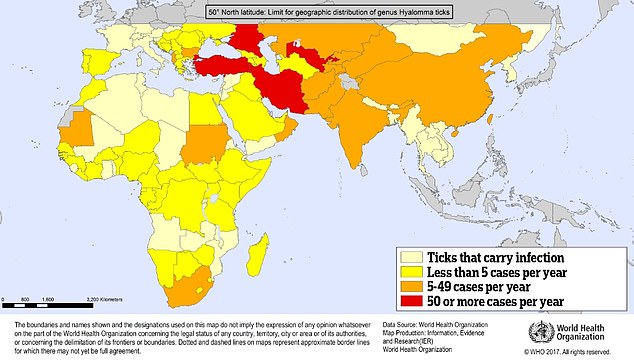Teenager infected with extremely deadly ‘eye-bleeding’ virus that kills a third of its victims



A 14-year-old boy has contracted a deadly infection that kills 30 percent of patients and has terrible symptoms, including bleeding from the eyes.
The teenager infected with the virus, called Crimean-Congo hemorrhagic fever (CCHF), is currently in isolation in hospital.
The disease, which leads to multiple organ failure, is spread through bites from infected ticks or through direct contact with infected animal blood.
The latest patient comes from Pakistan, where another suspected case has also been reported.

The World Health Organization map shows the distribution of CCHF cases worldwide by year. Turkey, Iran, Uzbekistan and parts of Russia register more than 50 cases per year. Meanwhile, five to 49 cases are detected annually in parts of Europe (Bulgaria and Albania), Africa (South Africa, Sudan and Mauritania) and Asia (India, Pakistan, Afghanistan, Oman, China and Kazakhstan)

Health leaders said the risk to public health was low because the disease is usually spread through bites from ticks that are not native to the UK and is not easily transmitted between people. Pictured: Stock photo of tick
Although CCHF is endemic in places with warm climates, experts warn the disease could soon be found in the UK.
Although CCHF is endemic in places with warm climates, experts warn the disease could soon be found in the UK.
Professor Isabel Oliver, chief scientific adviser at the UK’s Health Security Agency, has previously said the risk of Britons contracting the disease could increase due to global warming.
Experts say climate change could allow infected ticks to spread further and thrive in new environments.
A report published last year found that similar diseases, including Rift Valley fever, occur in 26 European countries.
Other diseases that health officials are on extra alert for include dengue, chikungunya, West Nile disease, yellow fever and Zika.
Symptoms of CCHF usually appear within three days of being bitten by an infected tick. They include fever, muscle aches, dizziness, and sore eyes.
According to the World Health Organization, nausea, vomiting, abdominal pain and mood swings are also common early symptoms of the disease.
Within a week, patients may experience a racing heart, bleeding rashes and blood flowing from small capillaries, for example around the eyes.
Organs such as the liver begin to fail.
There are limited treatments for the condition, although doctors have seen some success with the antiviral drug ribavirin, which is used to treat hepatitis C.
The disease was first discovered in 1944 in Crimea and was named Crimean hemorrhagic fever.
But in 1969, doctors discovered that the pathogen that caused this disease was also responsible for a disease identified in Congo in 1956.
Therefore, the virus was given the name Crimean-Congo hemorrhagic fever, to encompass both areas.
Today the disease is endemic in Africa, the Middle East and some Asian countries.
According to the WHO, in previous outbreaks of CCHF, between 10 and 40 percent of those infected died.
In 2022, doctors in London announced that they were treating a woman with CCHF who had recently traveled to Central Asia.
This was only the third case recorded in England.
The following year, the virus was first discovered in France.
Live ticks collected from cattle in the Pyrénées Orientales region were found to be carriers of the disease.
According to Prof Oliver of the UKHSA, the risk to the UK population is currently ‘very low’.




